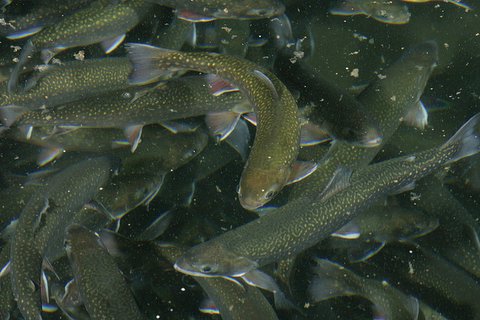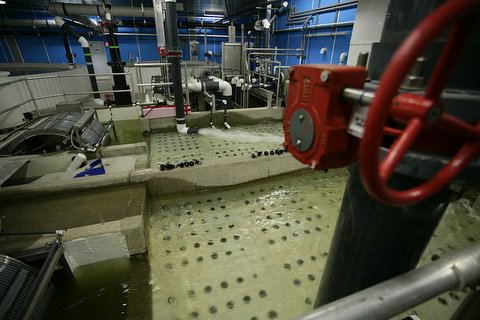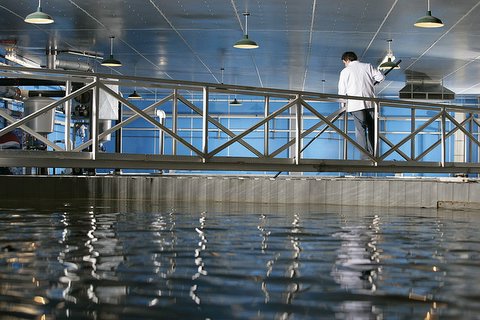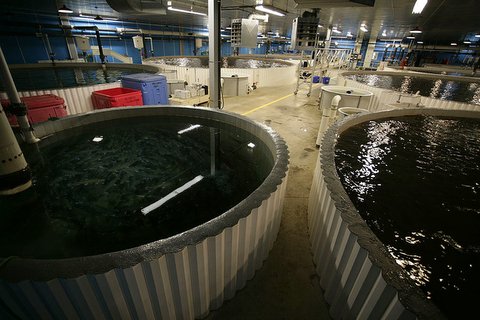Millbrook's Dive into Aquaculture
by Cate Barratt
Senior Communications Manager, Fisheries and Oceans Canada, Maritimes Region
Arctic charr's flesh is coral-coloured, with a delicate flavour that many say surpasses that of trout and salmon. It's a versatile fish, but one that isn't as well known as other farmed fish. Millbrook First Nation business Nova Scotia Arctic Charr wants to change that.
There are very few aquaculture producers of charr; in fact, the world's annual production is a mere 4000 metric tons-or about nine million pounds. Of that total, Iceland supplies two-thirds, while Nova Scotia Arctic Charr's production is currently 110 metric tons a year, clearly making it one of the smaller suppliers. Still, the owners will be able to move between 5,000 and 6,000 lbs. of Arctic charr out of the facility each week, destined for discriminating palates across the continent. Owned and operated by Millbrook Aquaculture, the company markets its farmed fish to higher end restaurants in both Canada and the United States.
The aquaculture operation was the dream of Millbrook First Nation, a Mi'kmaq community that calls Nova Scotia home. First Nations people in the Maritime Provinces turned a corner in 1999 with the Marshall decision by the Supreme Court of Canada. Their right (among others) to make a moderate living from the sea was affirmed in that judgment and Millbrook, along with other First Nations groups, took its place at the table to negotiate licences in various fisheries around Nova Scotia. Millbrook First Nation is a progressive band. Its members wanted to blaze a different trail, so they put forward a proposal to Fisheries and Oceans Canada (DFO) to start an aquaculture operation. After a feasibility study and business plan were accepted in 2002, Nova Scotia Arctic Charr was in business in Millbrook.
Not only is the facility the first to be run by a First Nation, but it has a number of unique features. To begin with, the Millbrook facility is land based. Initially, the band considered situating the facility at its wharf in Sheet Harbour where they had an existing wharf, but that idea was soon abandoned in favour of locating the facility on the Millbrook Reserve itself. Being situated within the community affords a number of advantages: First, it serves as a daily visual reminder of the band's enterprising success. Second, the business's five employees must reside within 15 minutes of the facility in order to quickly attend to any system glitches. Third, wastes from the tank water are converted to a non-toxic nitrate, which is then directed to the municipal sewage system and treated at the county treatment plant, removing any potential environmental impact on surrounding natural resources.
The nitrate gets another use as well: co-located with the aquaculture facility is a Millbrook-owned greenhouse, where three employees are responsible for growing aquaponic bedding and annual plants. Their feed is the nitrate from the fish farm next door - a marvellously efficient and environmentally responsible disposal of the effluent. Beginning in the summer of 2006, a variety of traditional Aboriginal healing herbs will be added to the greenhouse's inventory, which will be featured at the Glooscap interpretive centre located nearby.
Nova Scotia Arctic Charr purchases its fish eggs from northern suppliers, which are then hatched and grown out to about 100 grams (or six inches) by a local hatchery. Remarkably, while it can take upwards of a year to grow the fish to that size, they hit an amazing growth spurt over the next 12 months. After spending a year in Nova Scotia Arctic Charr's tanks, they reach 1500 grams (or between 3 and 4 pounds). This is when the charr is ready for market.
Again this year, Nova Scotia Arctic Charr mounted a promotional booth at the Boston Seafood Show, where it was one of only two purveyors of this outstanding fish, and the sole provider of samples. It seems that the image of Nova Scotia-grown fish is appealing to consumers - hence, restaurateurs are drawn to Millbrook's product. Needless to say, they were a big hit, which suits project coordinator Dave Roberts just fine. "We know we have an excellent product, but so much of marketing is about image. Once the fish is on someone's fork, we'll have a Nova Scotia Arctic Charr fan for life."
Because of the limited public awareness of charr, promotional efforts have to be stepped up. In addition, the company sells directly to restaurants (their charr graces the menu at the nation's House of Commons Parliamentary dining room in Ottawa), meaning the marketing division at the facility is always hard at work. But a growing consumer trend towards increased fish consumption, a quality product, and an environmentally and economically sustainable land-based aquaculture operation make the job a lot easier.
Millbrook First Nation is certainly proud of the success of its company - all the more so because arctic charr has a cultural significance to Aboriginal Canadians. But they're not content to rest on their laurels, though: they have an eye on the future, too. This progressive band hopes to expand into other areas and species in the coming years. In the meantime, their goal is to educate others about the charms of charr.

These are 1-2 kg (2-4 lb) Arctic Charr ready for market.

The water in tanks is completely filtered every 40 minutes through this filtration system.

This catwalk provides workers easy access to the larger tanks to carry out cleaning operations.

A bird's eye view of the 10 tanks at Nova Scotia Arctic Charr.
- Date modified: